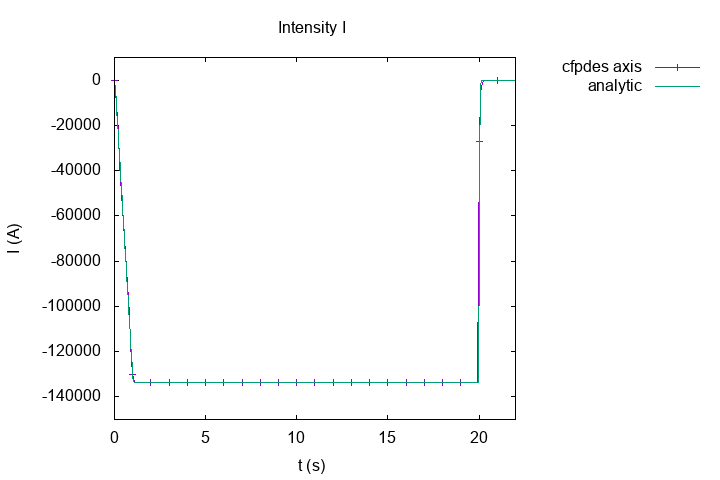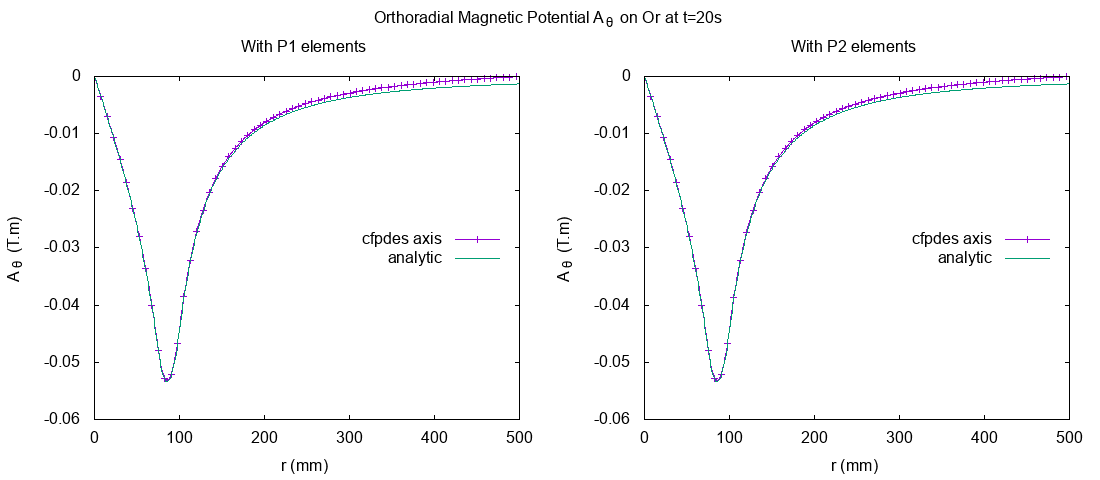Test case : One Torus
1. Introduction
In this page, I present the test case of Maxwell Quasi Static Problem in A-V Formulation with gauge condition for a geometry of torus surrounded by air for instationnary case in Axisymmetrical case.
2. Run the calculation
The command line to run this case is :
mpirun -np 16 feelpp_toolbox_coefficientformpdes --config-file=mqs.cfg --cfpdes.gmsh.hsize=1e-3
3. Data Files
The case data files are available in Github here :
-
CFG file - Edit the file
-
JSON file - Edit the file
-
GEO file - Edit the file
4. Equation
We solve the A-V Formulation in axisymmetric and we assume that \(V\) is known.
The unknow of equation is \(\Phi = r \, A_{\theta}\) but we want Magnetic Potential field \(A_{\theta}\).
With :
-
\(\Phi = r A_{\theta}\) : \(A_{\theta}\) component \(\theta\) of potential magnetic field
-
\(\sigma\) : electric conductivity \(S/m\)
-
\(\mu\) : electric permeability \(kg/A^2/S^2\)
-
\(U\) : tension \(Volt\)
5. Geometry
The geometry is a torus of conductor in cartesian coordinates \((x,y,z)\) or rectangle in axisymmetric coordinates \((r,z)\), surrounded by air.
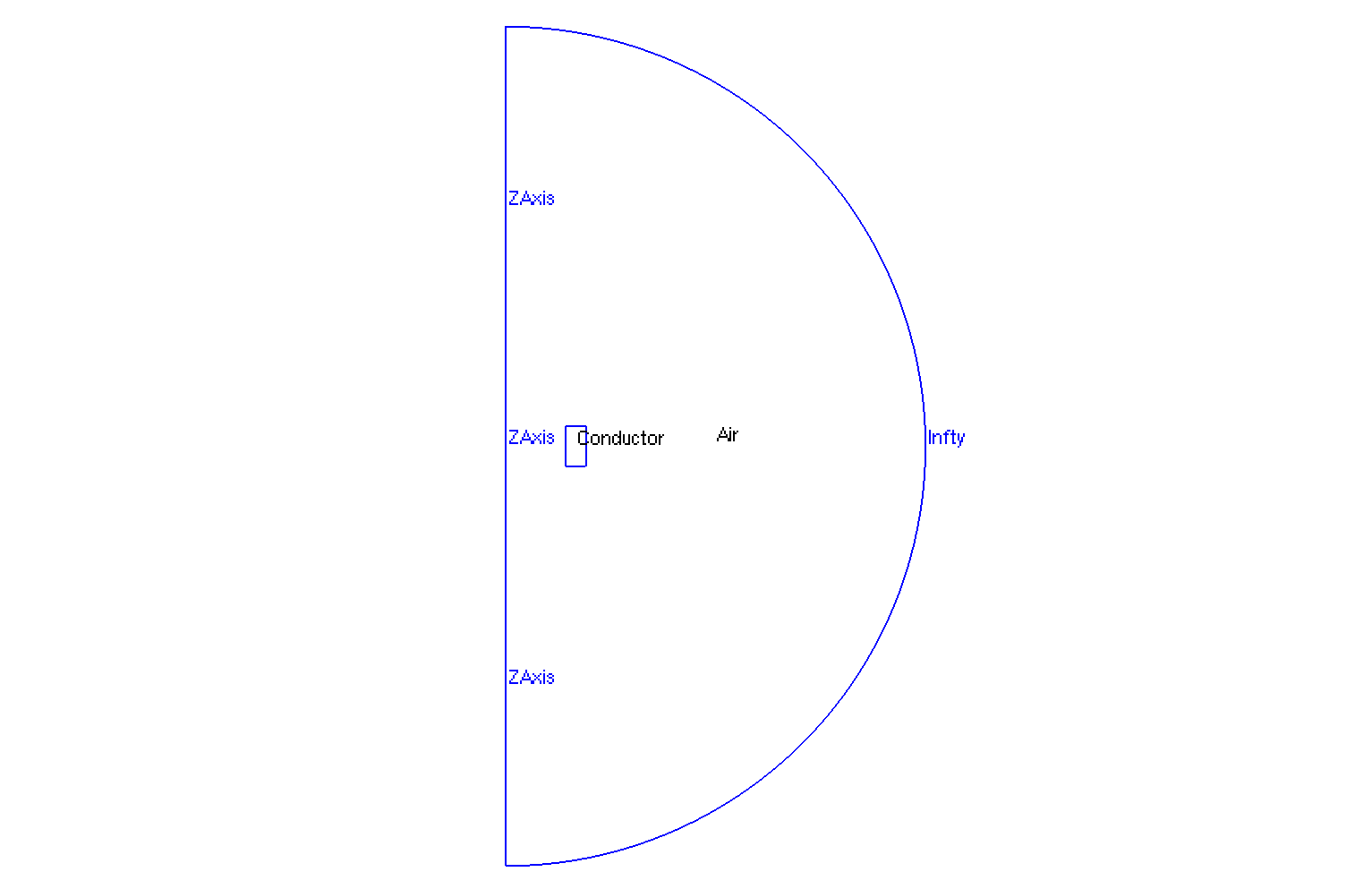
Geometry in Axisymmetrical cut
|
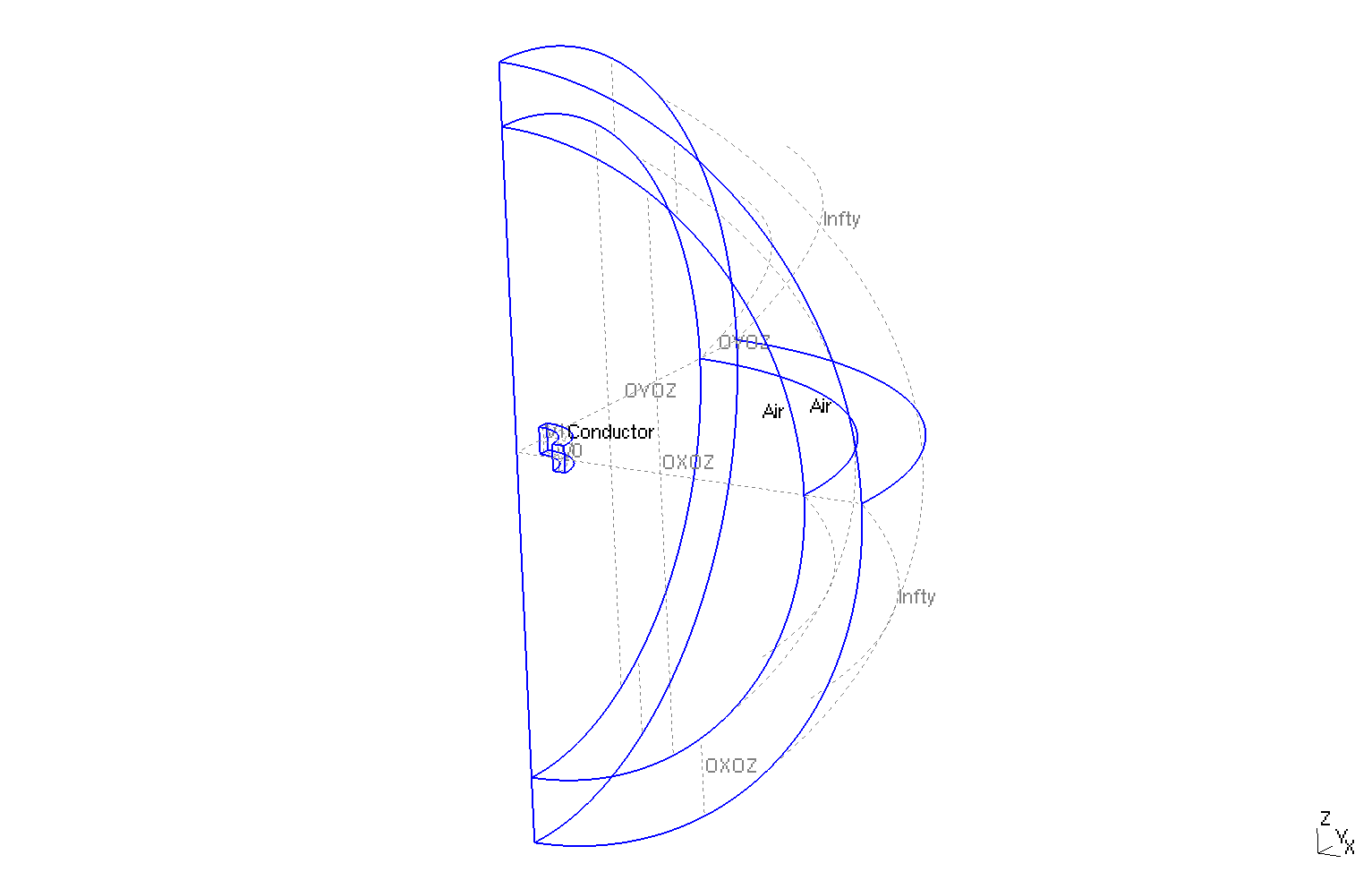
Geometry in three dimensions
|
The geometrical domains are :
-
Conductor: the torus, it is composed of conductive materials -
Air: the air surroundConductor-
zAxis: a bound ofAir, correspond to \(zO\) axis (\(\{(z,r), \, z=0 \}\)) -
infty: the rest of bound ofAir
-
Symbol |
Description |
value |
unit |
\(r_{int}\) |
interior radius of torus |
\(75e-3\) |
m |
\(r_{ext}\) |
exterior radius of torus |
\(100.2e-3\) |
m |
\(z_1\) |
half-height of torus |
\(25e-3\) |
m |
\(r_{infty}\) |
radius of infty border |
\(5*r_{ext}\) |
m |
6. Initial/Boundary Conditions
We impose the Dirichlet boundary conditions :
-
On
zAxis: \(\Phi = 0\) (\(A_{\theta} = 0\) by symetric argument) -
On
infty: \(\Phi = 0\) (\(A_{\theta} = 0\) we consider the bound of resolution like infty for magnetic field)
We initialize :
-
On
Conductor: \(\Phi(t=0,r,z) = 0\) (\(A_{\theta}(t=0,r,z) = 0\)) -
On
Air: \(\Phi(t=0,r,z) = 0\) (\(A_{\theta}(t=0,r,z) = 0\))
On JSON file, the boundary conditions are writed :
"BoundaryConditions":
{
"magnetic":
{
"Dirichlet":
{
"ZAxis":
{
"expr":"0"
},
"Infty":
{
"expr":"0"
}
}
}
}
For initial condition, we write nothing in JSON, by default the application put zeros on initialization.
7. Weak Formulation
We obtain :
With \(\tilde{\nabla} = \begin{pmatrix} \frac{\partial}{\partial r} \\ \frac{\partial}{\partial z} \end{pmatrix}\)
8. Parameters
The parameters of problem are :
-
On
Conductor:
Symbol |
Description |
Value |
Unit |
\(V\) |
scalar electrical potential |
\( U \, \frac{\theta}{2\pi}\) |
\(Volt\) |
\(U\) |
electrical potential |
\(1\) |
\(Volt / rad\) |
\(\sigma\) |
electrical conductivity |
\(58e6\) |
\(S/m\) |
\(\mu=\mu_0\) |
magnetic permeability of vacuum |
\(4\pi.10^{-7}\) |
\(kg \, m / A^2 / S^2\) |
-
On
Air:
Symbol |
Description |
Value |
Unit |
\(\mu=\mu_0\) |
magnetic permeability of vacuum |
\(4\pi.10^{-7}\) |
\(kg \, m / A^2 / S^2\) |
On JSON file, the parameters are writed :
"Parameters":
{
"U":"t/(0.1*10)*(t<0.1*10)+(t<0.5*40)*(t>(0.1*10)):t" // Volt
}
9. Coefficient Form PDEs
We use the application Coefficient Form PDEs. The coefficient associate to Weak Formulation are :
-
On
Conductor:
Coefficient |
Description |
Expression |
\(d\) |
damping or mass coefficient |
\(\sigma\) |
\(c\) |
diffusion coefficient |
\(\frac{r}{\mu}\) |
\(\beta\) |
convection coefficient |
\(\begin{pmatrix} \frac{2}{\mu} \\ 0 \end{pmatrix}\) |
\(f\) |
source term |
\(- \sigma \frac{U}{2\pi} \, r\) |
-
On
Air:
Coefficient |
Description |
Expression |
\(c\) |
diffusion coefficient |
\(\frac{r}{\mu}\) |
\(\beta\) |
convection coefficient |
\(\begin{pmatrix} \frac{2}{\mu} \\ 0 \end{pmatrix}\) |
On JSON file, the coefficients are writed :
"Materials":
{
"Conductor":
{
"sigma":58e+6, // S.m-1
"mu":"4*pi*1e-7", // kg.m/A2/S2
"magnetic_c":"x/mu:x:mu",
"magnetic_beta":"{2/mu,0}:mu",
"magnetic_f":"-sigma*U/2/pi*x:sigma:U:x:mu",
"magnetic_d":"sigma*x:x:sigma"
},
"Air":
{
"mu":"4*pi*1e-7", // kg.m/A2/s2
"magnetic_c":"x/mu:x:mu",
"magnetic_beta":"{2/mu,0}:mu"
}
}
10. Numeric Parameters
-
Time
-
Initial Time : \(0s\)
-
Final Time : \(240s\)
-
Time Step : \(10s\)
-
-
Mesh size :
-
Interior of torus : \(0.001 m\)
-
Far of torus : \(0.004 m\)
-
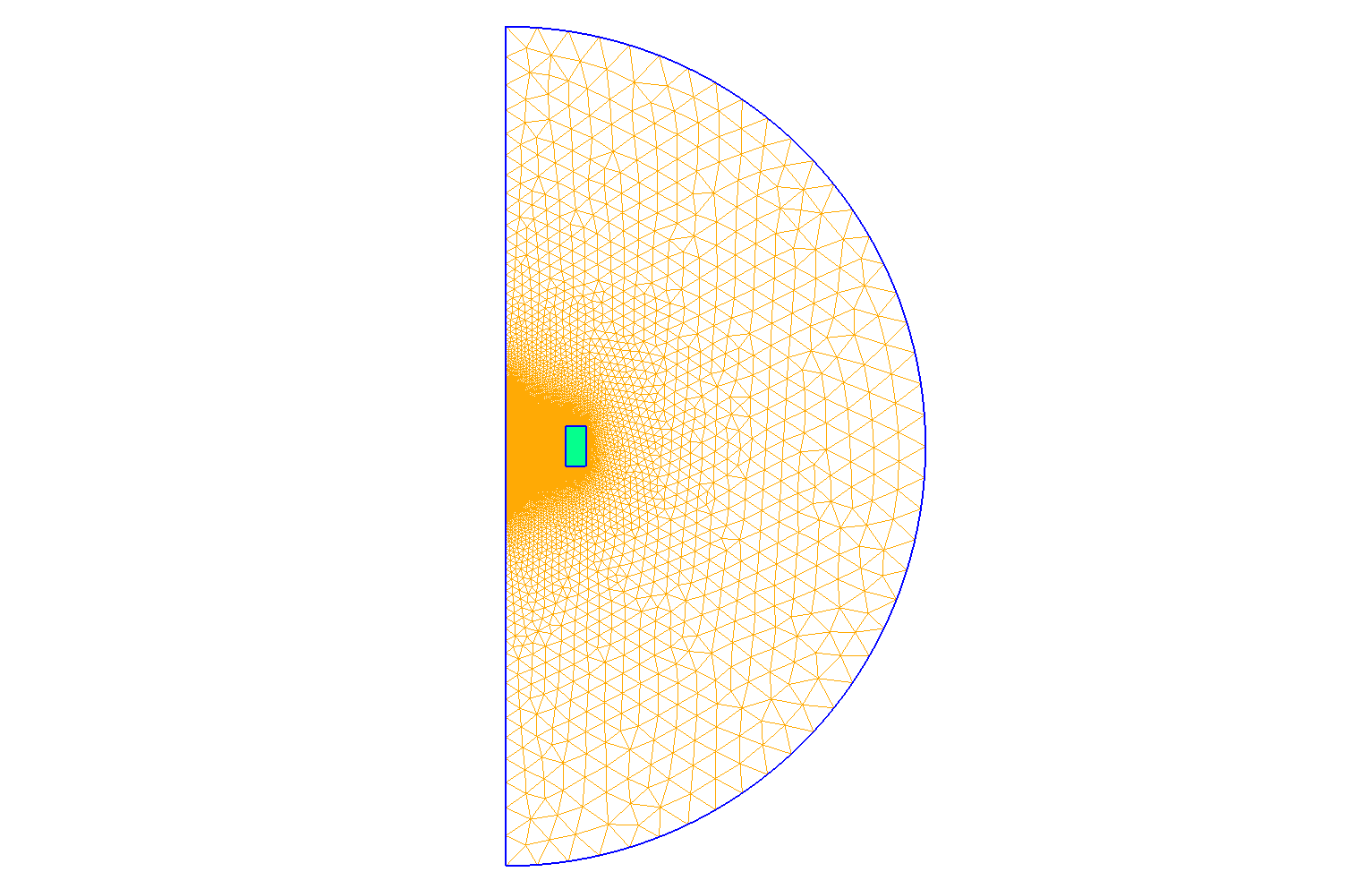
Mesh of Geometry
|
11. Export
We solve an equation (A-V Formulation in axisymmetric) of unknow \(\Phi = r \, A_{\theta}\) but we want the magnetic field \(\mathbf{B}\).
The potential magntic vector \(\mathbf{A}\) is define :
So, with rotational in cylindric and axisymmetric condition :
We export from \(\Phi\) :
-
\(A_{\theta} = \frac{\Phi}{r}\)
-
\(B_r = - \frac{1}{r} \frac{\partial \Phi}{\partial z}\)
-
\(B_z = \frac{1}{r} \frac{\partial \Phi}{\partial r}\)
13. Result
The analytical solve of potential magnetic field and magnetic field (the cyan curve on plots) is computed by python3’s module MagnetTools.MagnetTools. The module based on paper : spire.
The analytical solve of intensity (and magnetic field) is computed on python3’s script Edit the file.
13.3. Magnetic Field
Horizontal Magnetic Field \(B_z (T)\)
|
13.3.1. On Or axis at \(t=20s\)
I export the magnetic field at \(t=20s\) because we consider at this time, the system is stationary. Thus, we can compare with the analytical solve of stationnary problem.
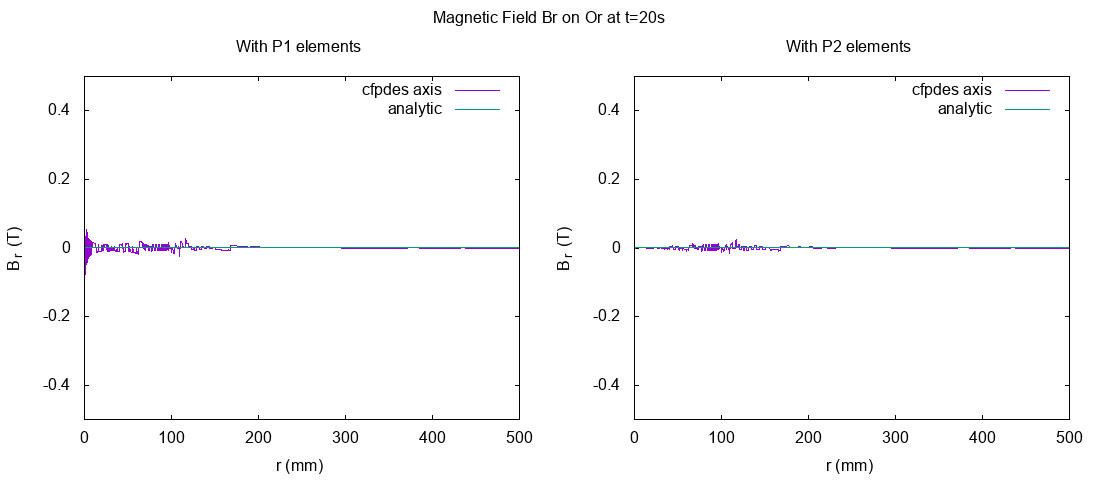
\(B_r (T)\) on Or axis
|
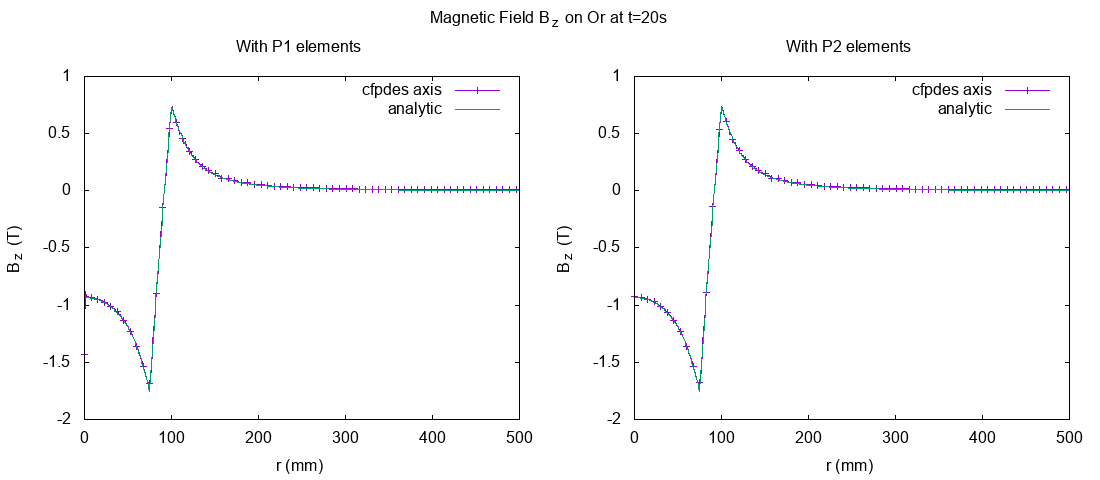
\(B_z (T)\) on Or axis
|
Around the Or axis, the direction of Magnetic field \(B\) is horizontal, in particulary at \(P0=(r=0,z=0)\).
We can observe a great difference between the resolution with P1 and P2 elements at \(r=0\) :
.png)
\(B_z (T)\) on Or axis
|
The result in P1 elements have instability near of \(r=0\) but not with \(P2\). This instability can be explain by the method of export of Magnetic Field : to have \(B_z\), we export \(\frac{1}{r} \frac{\partial \Phi}{\partial r}\) and the division \(\frac{1}{r}\) near of \(r=0\) can be a problem.
13.3.2. On \(P0=(r=0,z=0)\) in terms of time
The value of magnetic field on \(P0=(r=0,z=0)\) is important because the research put theire experiments near of this point.
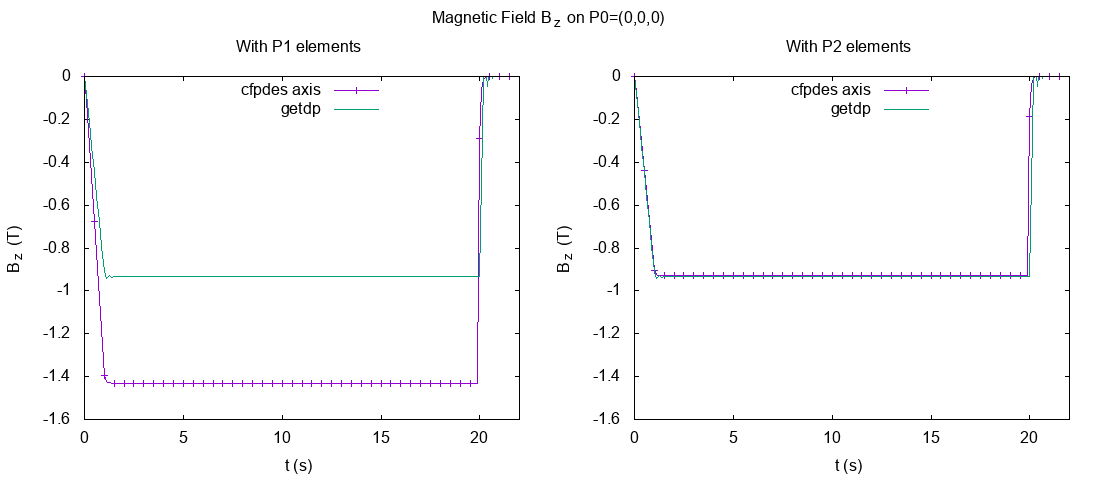
\(B_z (T)\) on P0
|
We can see a difference between the result \(B_z\) with P1 and P2 element. The curve of z-magnetic field \(B_z\) in P1 element is far of analytical solve and in P2, it seems good. The phenomena is explain by the remark above.
14. References
-
Calcul du champ magnétique pour les géométries axisymétriques simples, Christophe Trophime, 2002, unpublished, Download the PDF
